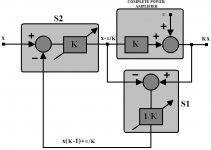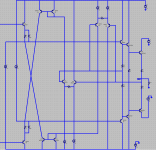Stuart,
My understanding (I'm not an expert on the 405) is that the 405 is a "feed-forward" design, so it is distinctly different. Actually, it may be one of the only if not the only commercial FF design.
My understanding is that it uses two amplifiers in a sort of parallel configuration, one high power amp with a low pass response (courtesy of an output inductor), and one low power, high speed amp.
The idea is that the high distortion amp takes the bulk of the power dissipation and the faster, more accurate amp provides smaller currents to reduce the distortion.
If you read the articles written at the time you'll see the limitations of this technique. Mainly that the HF current capability is very limited so the choice of speaker and cables is rather important and the peak power is limited.
Brian
My understanding (I'm not an expert on the 405) is that the 405 is a "feed-forward" design, so it is distinctly different. Actually, it may be one of the only if not the only commercial FF design.
My understanding is that it uses two amplifiers in a sort of parallel configuration, one high power amp with a low pass response (courtesy of an output inductor), and one low power, high speed amp.
The idea is that the high distortion amp takes the bulk of the power dissipation and the faster, more accurate amp provides smaller currents to reduce the distortion.
If you read the articles written at the time you'll see the limitations of this technique. Mainly that the HF current capability is very limited so the choice of speaker and cables is rather important and the peak power is limited.
Brian
traderbam said:jcx wrote:
My insistance is because I believe the misconception can actually lead to narrow thinking...specifically, the failure to see a simpler topology that will lead to a simpler implementation.
Actually the reverse is true.
We have been perfecting the cannonical (1 degree of freedom to acknwledge the distinction by jcx) for 40 years. Weary of sweeping statements that most often than not come back to bite, it could be said no breaktrhoughs in this scheme are foreseeable.
The error correction conception (a probably much more meaningful label for a certain class of 2 degree of freedom systems), shifts the design goal from an "as much as gain as you can afford to bargain while remaining alive", to an "as much linear and wideband unity gain difference amplifier as you can design".
I can hardly qualify this added possibility as narrowmindedness.
And I have not even mentioned the digital implementation possibilities this approach affords, something I am currently working on. And digital is the future (and present) - a statement I am not afraid may come back to bite me -
Rodolfo
ingrast said:
...... digital is the future (and present) - a statement I am not afraid may come back to bite me -
Rodolfo
Not as long as nature remains resolutely analogue.
ingrast said:
...digital implementation possibilities this approach affords, something I am currently working on.
Rodolfo
Paper on Hawksford's web site.
mikeks said:
Not as long as nature remains resolutely analogue.
Good joke !!!!
Rodolfo
Rodolfo wrote:
I think you just said that you can make a more linear gain block (integrator block?) by using a wide-band, unity-gain amplifier, with a PFB loop around it.
Surely in either method, the crux is the unity gain bandwidth and phase margin, right? In either case you are generating the highest, stable gain you can? How is this different?
Now you are talking about the thing I asked you a few pages ago...what are the advantages of a PFB loop gain block to a conventional gain block? Good.shifts the design goal from an "as much as gain as you can afford to bargain while remaining alive", to an "as much linear and wideband unity gain difference amplifier as you can design".
I think you just said that you can make a more linear gain block (integrator block?) by using a wide-band, unity-gain amplifier, with a PFB loop around it.
Surely in either method, the crux is the unity gain bandwidth and phase margin, right? In either case you are generating the highest, stable gain you can? How is this different?
traderbam said:...Now you are talking about the thing I asked you a few pages ago....... [/B]
Sorry, I thought it was apparent from the begining.
Rodolfo
ingrast said:Link available?
Here's a link to his papers:
http://www.essex.ac.uk/ESE/research/audio_lab/malcolms_publications.html
traderbam said:He, he, Rodolfo. I think the one truth here is that what we each consider to be blindingly obvious to others is often quite invisible.
 Nothing unheard of before for sure!!!
Nothing unheard of before for sure!!!Rodolfo
Thanks !!andy_c said:
Here's a link to his papers:
http://www.essex.ac.uk/ESE/research/audio_lab/malcolms_publications.html
mikeks said:It has occurred to me that a complete power amplifier may be enclosed within the error loop as shown below.
Discuss.
Michael, kindly, I hate to have to point it out, but this is exactly what I proposed from the begining. Am I having a fatal communications impairment?
Rodolfo
PS one of my early validation tests (circa Jan/2005) was to correct a 20 dB gain LM3886. It worked better than a regular 20 dB LM3886 configuration, but worse than a 20 dB CFP bipolar/MOS output stage (the one I showed elsewhere some months back).
mikeks said:Another possible arrangement?
Mike, I don't think you need those current mirrors. For each diff amp, you can take one collector and hook it up to the parallel RC. Then you can take the other collector and hook it up to the emitter of the emitter follower at the input. Notice this results in a constant current of the emitter follower, even as the error correction current varies.
Then you might imagine floating the diff amp current sources so they're bootstrapped to the output voltage somehow. This may be more practical with FET output devices, as the bipolars develop so little voltage drop that VCE crowding of the error correction transistors or their current sources could result.
ingrast said:
Michael, kindly, I hate to have to point it out, but this is exactly what I proposed from the begining.
Where?
Must have missed it.
that, sir, is an excellent idea
mlloyd1
mlloyd1
pooge said:Has anyone thought about inviting Malcolm into the discussion???
His email address is posted on his site. Might be enlightening to hear some words out of the "horse's mouth".
- Home
- Amplifiers
- Solid State
- Bob Cordell Interview: Error Correction



